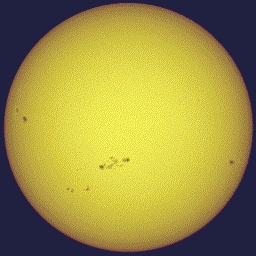The Sun is a ball of gas, so it does not have a well-defined surface. When we speak of the surface of the Sun, we normally mean the photosphere.
- The photosphere is the lowest layer of the Sun’s three main atmospheric layers. It is the layer from which the Sun’s visible light emanates. Just above the photosphere lies the chromosphere.
- The Chromosphere is the layer of the Sun lying just above the photosphere. It is less than 20,000 km thick and separates the photosphere, at about 6000 degrees K, from the much hotter corona, at temperatures in the millions of degrees Kelvin.
- The Corona is the Sun’s faint (and hot) outer atmosphere, extending from about 20,000 km above the photosphere to at least several solar radii, although its boundary is not defined. The temperature of the corona is about 1.5 million Kelvin.
Source: Alexander, P. EOS, Bull. Amer. Geophys. U. 73, 433, 1992.
Golub, L. and Pasachoff, J. M. The Solar Corona. Cambridge, England: Cambridge University Press, 1997.
Stern, D. and Peredo, M. “The Sun’s Corona.” http://www-spof.gsfc.nasa.gov/Education/wcorona.html.
© 1996-2007 Eric W. Weisstein
The Photosphere:
 The photosphere is the visible surface of the Sun that we are most familiar with. Since the Sun is a ball of gas, this is not a solid surface but is actually a layer about 100 km thick (very, very, thin compared to the 700,000 km radius of the Sun). When we look at the center of the disk of the Sun we look straight in and see somewhat hotter and brighter regions. When we look at the limb, or edge, of the solar disk we see light that has taken a slanting path through this layer and we only see through the upper, cooler and dimmer regions. This explains the “limb darkening” that appears as a darkening of the solar disk near the limb.
The photosphere is the visible surface of the Sun that we are most familiar with. Since the Sun is a ball of gas, this is not a solid surface but is actually a layer about 100 km thick (very, very, thin compared to the 700,000 km radius of the Sun). When we look at the center of the disk of the Sun we look straight in and see somewhat hotter and brighter regions. When we look at the limb, or edge, of the solar disk we see light that has taken a slanting path through this layer and we only see through the upper, cooler and dimmer regions. This explains the “limb darkening” that appears as a darkening of the solar disk near the limb.
A number of features can be observed in the photosphere with a simple telescope (along with a good filter to reduce the intensity of sunlight to safely observable levels). These features include the dark sunspots, the bright faculae, andgranules. We can also measure the flow of material in the photosphere using the Doppler effect. These measurements reveal additional features such assupergranules as well as large scale flows and a pattern of waves and oscillations.
The Sun rotates on its axis once in about 27 days. This rotation was first detected by observing the motion of sunspots in the photosphere. The Sun’s rotation axis is tilted by about 7.25 degrees from the axis of the Earth’s orbit so we see more of the Sun’s north pole in September of each year and more of its south pole in March.
Since the Sun is a ball of gas it does not have to rotate rigidly like the solid planets and moons do. In fact, the Sun’s equatorial regions rotate faster (taking about 24 days) than the polar regions (which rotate once in more than 30 days). The source of this “differential rotation” is an area of current research in solar astronomy.
Read and see more about the sun at http://solarscience.msfc.nasa.gov/surface.shtml
<
p align=”left”>






























